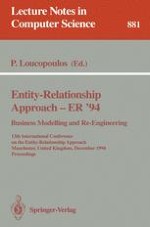1994 | Buch
Entity-Relationship Approach — ER '94 Business Modelling and Re-Engineering
13th International Conference on the Entity-Relationship Approach Manchester, United Kingdom, December 13–16, 1994 Proceedings
herausgegeben von: Pericles Loucopoulos
Verlag: Springer Berlin Heidelberg
Buchreihe : Lecture Notes in Computer Science
Enthalten in: Professional Book Archive
